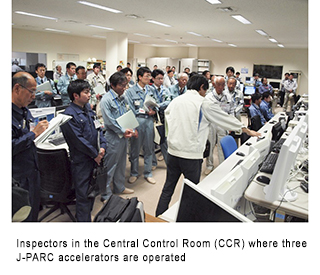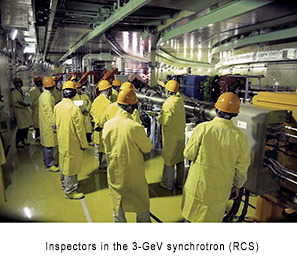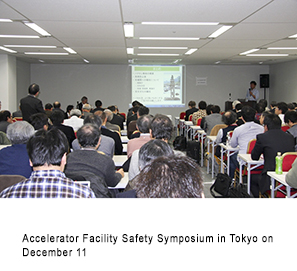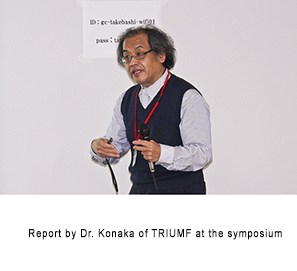| Ā°Ā@J-PARC News - December 2013 (Issue #104) |
| ĀúOn-Site Inspection by Local Governments to Confirm Measures to Prevent Recurrence of a Radioactive Material Leakage Accident (December 5) |
| An on-site inspection was carried out by Ibaraki Prefecture, Tokai Village, neighboring cities, and regional municipalities, in order to confirm facility soundness, safety management systems and other factors, at all facilities except the Hadron Experimental Facility (hereafter, the HD facility). The primary subjects of this on-site inspection in each facility were (1) a current status of equipment operation, radiation monitoring and management of negative pressure in radiation controlled areas, (2) equipment improved after the accident, and (3) other related issues. Documentation such as rules, operation manuals, and reports/records on emergency drills was also examined. On the day of the inspection, the event was covered by eight companies from the news media. |
  |
 * Click here to enlarge. * Click here to enlarge. * Click here to enlarge. * Click here to enlarge. |
| Ā£to Page Top |
|
| ĀúHeld Meeting of Radiation Safety Review Committee (December 9) |
| On October 1, the reorganized framework became effective in order to strengthen our evaluation system of issues related to radiation safety standards, such as revision of safety standards and rules for each facility and equipment. The Radiation Safety Review Committee (RSEC) comprised of specialist members including external experts was newly established to replace the Internal Radiation Safety Committee comprised of representatives of the J-PARC staff members. The first RSEC meeting was held on December 9.
The chairman of the committee is Dr. Mamoru Baba, J-PARC's Deputy Director of Safety, and there are a total of 20 committee members, including four external experts, six staff members from the Japan Atomic Energy Agency (JAEA) and the High Energy Accelerator Research Organization (KEK) with extensive experience in work involving radiation, and members from the J-PARC Center, including radiation safety supervisors, and the Heads of the Safety Division and other divisions.
∗External Expert MembersMitsuo Tosaki : Associate Professor, Radioisotope Research Center, Agency for Health, Safety and Ā@Ā@Ā@Ā@Ā@Ā@Ā@Ā@Ā@Ā@ Environment, Kyoto UniversityTomokazu Suzuki: Radiation Safety Supervisor, Research Center for Nuclear Physics, Osaka UniversityKanenobu Tanaka: Safety Management Group, RIKEN Nishina Center for Accelerator-Based ScienceTomoyuki Takahashi: Associate Professor, Radiation Safety and Control, Department of Nuclear Science and Engineering , Kyoto University Research Reactor Institute |
  |
 * Click here to enlarge. * Click here to enlarge. |
| Ā£to Page Top |
|
| A meeting of the above committee, chaired by Dr. Koji Okamoto (Professor, Graduate School, The University of Tokyo) and comprised of experts in fields such as nuclear power, was held in Mito, and the J-PARC Center reported on efforts to prevent recurrence of a similar accident at the HD facility. At this committee Ibaraki Prefecture also reported on assessments of the on-site inspection of J-PARC conducted prior to this meeting on the 5th, saying that safety measures had been developed at J-PARC. Regarding the safety management system, the committee commented that, among other things, the J-PARC Center must work hard to continually improve, and promote information disclosure. |
| Ā£to Page Top |
|
| On December 12 and 13, we observed the gold target at the Hadron Experimental Facility by a fiberscope for the first time after the radioactive material leak accident that occurred at Hadron Experimental Facility on May 23, 2013.
As we reported previously, it has been considered that the target was damaged and partially evaporated by an accidental injection of a large amount of protons for a very short period (i.e., 5 micro sec.), and several simulations were carried out.
During the observation, we verified: 1) a hole 1 mm in diameter at a downstream end of the gold target (2) gold-colored nubs, which probably are traces of dripped out melting gold from slits of a gold rod of the target (3) probably droplets of melting gold on the copper base block (and 4) traces of sprayed out melting gold on a beryllium window at the downstream of beam. Please note that these droplets marks are observed only on the right side of the target as viewed from the downstream.
These observations nicely match with our simulation results. Consequently, we consider that, at the injection, temperature of the gold target partially exceeded melting and further vaporizing points, and melted gold was pushed outward due to a rapid volume expansion resulted from vaporization of the melted gold. |
|
| To install a neutron experiment instrument (BL) in the Materials and Life Science Experimental Facility (MLF), a BL installation proposal is first discussed by the Neutron Instrument Committee, and accepted proposal move on to the construction phase. The maximum period allowed for each BL is 10 years. An interim evaluation is conducted at the middle of the period, and an overall evaluation is conducted at the end of the period. On this basis, a guideline is issued regarding whether to continue the BL and extend the period.
In FY2013, five BLĀfs built in the initial stage of the J-PARC construction were subject to interim evaluation, and the Sub-committee of Neutron Instruments was held during November and December. The performance and outcomes of BLĀfs will be evaluated hereafter by the Committee, based on the evaluation report from the Sub-committee, and advice will be given on measures for further improving performance for the next 5 years. |
| Ā£to Page Top |
|
| The J-PARC Center held the Accelerator Safety Symposium in Tokyo. The purpose of this symposium was to strengthen safety management at an accelerator facility by sharing the lessons from the accident in J-PARC (hereafter the Hadron accident) with persons work at accelerator facilities, and exchanging experiences on safety management and information on issues at accelerator facilities both inside and outside Japan. To begin, the J-PARC Center reported on the details of the accident and its measures, followed by a discussion of related topics. Later, there were reports from the TRIUMF in Canada, and eight accelerator facilities in Japan (Research Center for Electron Photon Science, Tohoku University; Cyclotron and Radioisotope Center (CYRIC), Tohoku University; Riken RIBF; KEK; National Institute of Radiological Sciences; JAEA Takasaki Advanced Radiation Research Institute; RCNP, Osaka University; and SPring-8). At the end of the symposium, participants comprehensively discussed safety concepts and issues for accelerator facilities. There were also many participants from private companies, and a lively exchange of views between about 130 attendees. |
  |
 * Click here to enlarge. * Click here to enlarge. * Click here to enlarge. * Click here to enlarge. |
| Ā£to Page Top |
|
| This international workshop was held in Seoul, and there were lively discussions by about 30 experts from Japan, China and South Korea. (From Japan, there were four participants from J-PARC and Kyoto University). Attendees from J-PARC provided an overview of discussions by the Working Group for Evaluating Partitioning and Transmutation Technologies, organized by the Ministry of Education, Culture, Sports, Science and Technology in September and October of this year, as well as the ADS R&D situation in Japan. They also reported on evaluation of accelerator reliability, analyzed based on the operation history of J-PARC, and structural soundness of the nuclear spallation target of the ADS Target Test Facility (TEF-T).
This workshop began with an international symposium held in Tokyo in March 2003 by the Japan Atomic Energy Research Institute (currently the JAEA). Every year the workshop is held by Japan, South Korea or China, on a rotating basis, and the next workshop is scheduled to be held in China next year. |
| Ā£to Page Top |
|
| Every year, the Japan Society for Neutron Science presents Society Awards to people who have made major contributions to the development of neutron science. The award ceremony this year was held on the first day of the 13th Annual Meeting in Chiba on December 12-13.
From the J-PARC Center, two staff members received Encouragement Awards and one group received the Technology Award. The Encouragement Award was received by Dr. Takenao Shinohara, Assistant Principle Researcher, Neutron Science Section, for "Development of magnetic imaging with polarized pulse neutrons," and by Dr. Tatsuya Kikuchi, a limited-term researcher also of the Neutron Science Section, for "Development of a model-free analysis method for quasi-elastic neutron scattering and its application to water." In addition, a five-member group led by Dr. Kenji Nakajima, Principle Researcher from the same section, received the Technology Award for "Practical application of spectrometer of double disk chopper type for pulsed neutron source." |
 |
 * Click here to enlarge. * Click here to enlarge. |
| Ā£to Page Top |
|
| On December 16, 2013, the J-PARC neutrino beam group, which includes all contributors to make realized significant outcomes with using neutrinos produced in T2k experiments, has won the 2013 Suwa award in recognition of their contribution to the development of High Energy Accelerator Science.
This award is established by the Foundation for High Energy Accelerator Science (FAS) and is given to researchers, engineers and research groups who accomplished a great achievement such as a long-term contribution to the development of the high energy accelerator science.
The J-PARC neutrino beam group was recognized particularly for the realization of the worldĀfs highest intensity neutrino beam facility that was essential for a great experimental outcome by the T2K group, the discovery of the "Electron Neutrino Appearance Phenomenon".
Takashi Kobayashi, who is a professor of KEK and the Head of the Particle & Nuclear Physics Division of the J-PARC Center, accepted the award on behalf of all members of the neutrino beam group and thanked to all supports they received. |
| Ā£to Page Top |
|
Copyright 2011 JAEA and KEK Joint Project. All rights reserved.
|
|